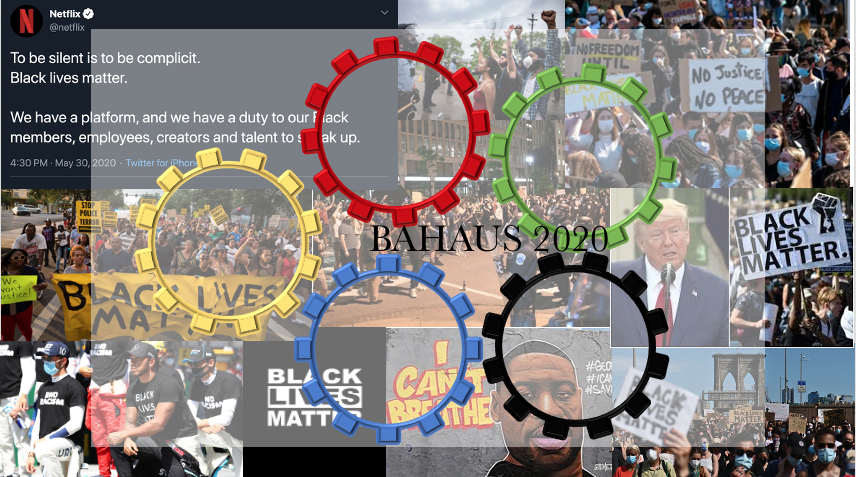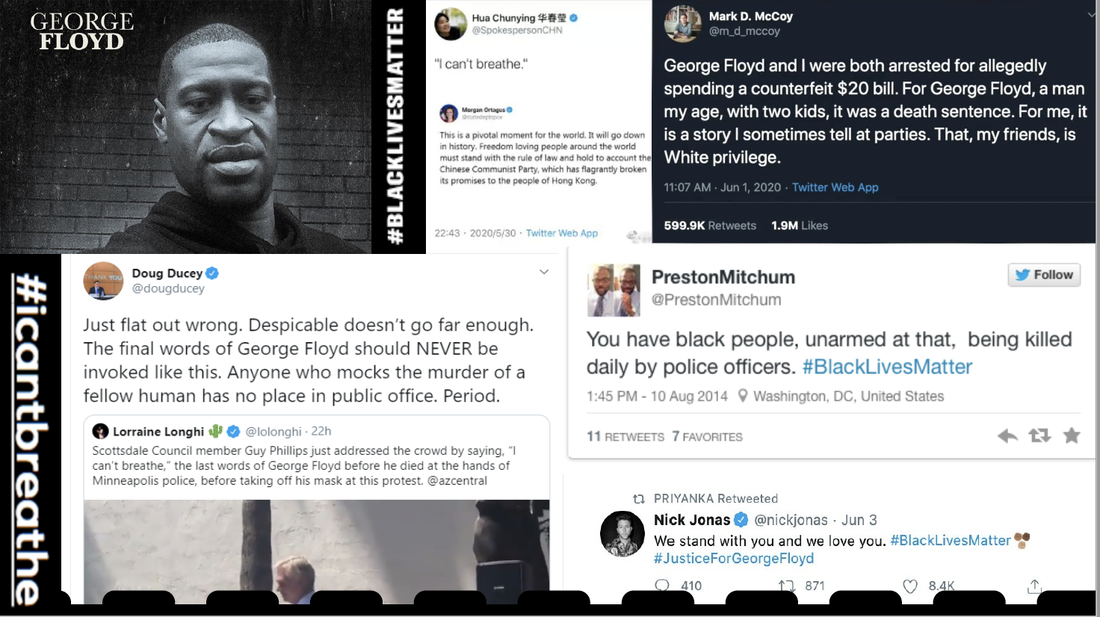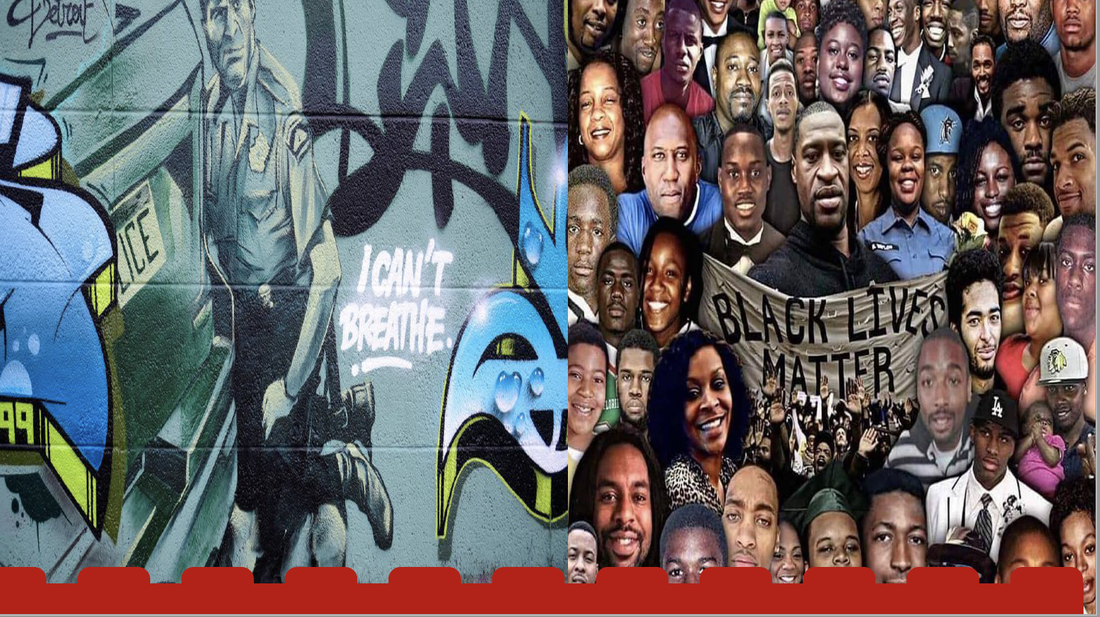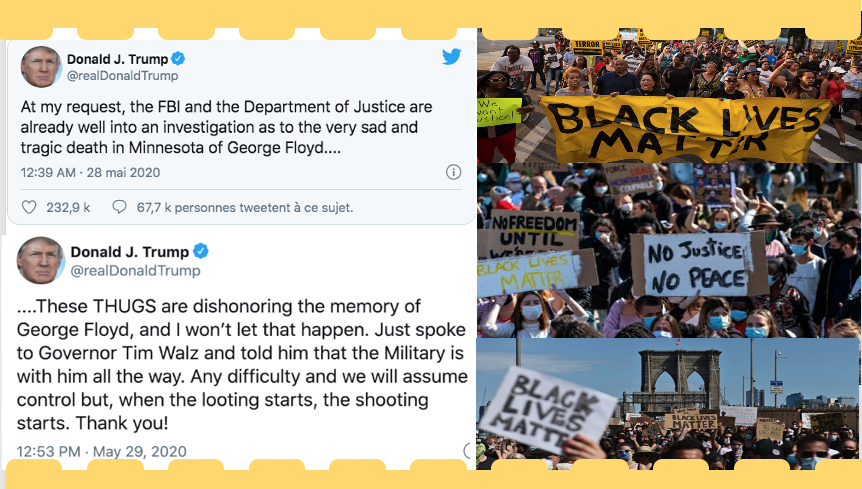|
Creation of the artwork around Bateson's 5 axioms of communication
1. To communicate is to enter into the orchestra The first wheel is expresses the basic idea developed by Bateson that to communicate is to enter the orchestra. In other words, for it to be successful, communication needs to be harmonious and tailored to the audience in order to reach one's target. In the aftermath of George Floyd’s killing, we witnessed dysfunctional communications opposing the Trump government on the one hand and Black Lives Matter protesters on the other. Each group has different codes, different channels that members adopt to communicate. Fig. 1. The wheels of communication.
3. One cannot not communicate The third axiom “One cannot not communicate » explains that it is impossible not to communicate. Indeed, for the Palo Alto School, existing means to communicate. Human beings communicate all the time as long as there are at least two people. The murder of George Floyd triggered reactions of indignation and of condemnation on social media and in demonstrations. These reactions came from prominent politicians like Joe Biden, from sports and arts personalities like Lebron James, or Nick Jonas but more importantly, from a multitude of anonymous people. In contrast, US President of the time, Donald Trump did not immediately react to the murder of George Floyd, notably via Twitter. Indeed, the American president is known for his twittomania as he emits numerous tweets several times a day. This again illustrated the significance of the Palo Alto axiom: even we say nothing, we are communicating. Our silence is interpreted often as acceptance of a situation or worse as a sign of complicity. Donald Trump’s silence in the three days following George Floyd’s murder was interpreted as communication nevertheless. When he finally broke that silence on the 28th of May, his communication only confirmed what many thought about his initial silence. 4. The nature of a relationship is dependent on the punctuation of the partners communication procedures
The fourth wheel represents the fourth axiom. This axiom explains that “The nature of a relationship is dependent on the punctuation of the partners communication procedures ». In an interaction, each locutor will interpret the sequence of interactions and will often attribute to the other, the origin or cause of a miscommunication and will view their own behaviour as merely a reaction to the other's behaviour. In other words, this axiom describes the classic behaviour observed in human interactions where one person thinks that the other person is responsible for the conflictual situation and that they are only reacting or responding to it. In the case of our topic, we have two groups: the protesters of the Black Lives Matter movement and the representatives of the law, which includes the government. When the video of George Floyd's murder by a police officer was shared on social networks, many people were shocked and outraged. This led to a wave of reactions on social networks and in demonstrations in the United States. The protesters and "rioters" took to the streets and tried to make their voices heard in a radical in a radical way. As the video of George Floyd killing went viral all over the world, so did the reactions that followed. This created a "snowball effect" and for many weeks the reactions followed one another. Indeed, the story of George Floyd is similar to many others in the US. The protesters want justice and want the racist killings to stop. It is the killing of George Floyd by the police that led to the reaction of Americans, of the Black Lives Matter movement. |
State, Police and Protesters: a dysfunctional communication cycle
It is an acknowledged fact that African-Americans are 2.5 times more likely to be killed by the US police than their white counterparts. According to a study by the Economic Policy Institute, the average income of African-Americans is half that of white Americans. This artwork used Wiener's cybernetics theory and the Palo Alto's five axioms of communication to illustrate the dysfunctional communication strategies between the American state and law enforcement orders, and the protesters of systemic racism following the brutal murder of George Floyd. Drawing upon Gregory Bateson’s (Palo Alto School) theories on interpersonal communication and in particular his five axioms of interpersonal communication which posit that communication is unavoidable in all human interactions, the artwork sought to portray how the communications between protesters and the authorities are shaped by the unhealthy nature of their relationship engendered by systemic racism in American society . Gregory Bateson was inspired by Norbert Wagner's cybernetics. Indeed, the Palo Alto School conceived communication as a system where everything is linked. The five axioms of the Palo Alto School allowed the students to show the link between the communication between protesters and the authorities, perceived as a wheel. If a piece is missing, the wheels won’t turn and the whole system will be gripped. As each axiom is exemplified with photographs of the Black Lives Matter movement, the artwork wanted to portray the cyclic and systemic nature of human communications, in this case, around the media treatment cycle of George Floyd’s murder into which the reader is caught. 2. Every communication has a content and relationship aspect such that the latter classifies the former and is therefore a metacommunication
The second wheel which represents the second axiom of the Palo Alto School. It explains that every communication has a content and relationship aspect such that the latter classifies the former and is therefore a metacommunication. The content, or the setting here, is a police arrest that was supposed to happen according to law, but turned into a brutal murder. The relationship between the police and African-Americans is to say the least, very unhealthy. In this relationship, there is an absence of dialogue and non-verbal communication prevailed over the verbal. If we look back at the scene, the suspect who becomes the victim in this event calls for help when he says the words "I can't breathe". During these 9 minutes, the victim's complaints and suffering are not heard by the police. As the second axiom of the Palo Alto School explains, taking into account the context is essential to understanding communication. We saw the importance of non-verbal language (relationship) which dominated over verbal language during the arrest and murder of George Floyd . This scene also illustrates another axiom of the Palo Alto school that "Human communication involves both digital and analog modalities". 5. Inter-human communication procedures are either symmetric or complementary The construction of the artwork is completed with the addition of the fifth wheel to represent the fifth axiom. According to the theory of the Palo Alto School, « Inter-human communication procedures are either symmetric or complementary» describes the nature of interactions between two interlocutors. Symmetrical communication describes an interaction based on equal power while the complementary describes interaction based on differences in power. These two styles play out in different ways: - "one-up" communication style where one of the interlocutors takes control of the exchange and dominates it; - "one-down" style where one of the interlocutors relinquishes control and is therefore in a submissive attitude; - "one-across" when one interlocutor seeks to neutralise a situation in their exchanges. When the interlocutors use the same style, the relationship is said to be symmetrical since both parties are on an equal footing and there is no hierarchy. Conversely, when their styles are different, the relationship is complementary, based on their difference in "power" over each other. The interactions between the Black Lives Matter protesters and the public authorities of the state of Minnesota where the murder of George Floyd took place illustrate these styles. On the one hand the BLM protesters adopted a 'one-up' style in order to take control of the public sphere in order to influence the political exchange and discourse, by demonstrating in the streets or using social networks. In this way they sought to be heard and to obtain justice for this and other previous murders, and to obtain an admission of police violence and the phenomenon of systemic racism in the United States. On the other hand, the City Hall and the Governor adopted a mix of "one-across" and 'one-up' approach in an effort to avert social unrest, political crisis while enforcing 'law and order’, and regaining control of the situation. For instance, Minnesota Governor’s Tim Walz authorised a full mobilisation of the militarised National Guard. Ultimately, the authorities engaged in a “one-up” interaction style as as well as there was little or no listening on their part, no conversation, empathy nor collaboration felt by the activists, who did not feel heard or understood, only violently repressed and ignored. However, this ‘one-up’ style is not explicitly “assumed”, rather, it is implicit and is reflected in the violent repression of the protesters. The desire to 'dominate' the relationship and take control of the people and of public opinion is not expressed as such since, in essence, the police are supposedly "guardians of order" in the American democracy.
|




